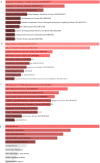Prediction of interactomic hub genes in PBMC cells in type 2 diabetes mellitus, dyslipidemia, and periodontitis
- PMID: 38532421
- PMCID: PMC10964604
- DOI: 10.1186/s12903-024-04041-y
Prediction of interactomic hub genes in PBMC cells in type 2 diabetes mellitus, dyslipidemia, and periodontitis
Abstract
Background and objective: In recent years, the complex interplay between systemic health and oral well-being has emerged as a focal point for researchers and healthcare practitioners. Among the several important connections, the convergence of Type 2 Diabetes Mellitus (T2DM), dyslipidemia, chronic periodontitis, and peripheral blood mononuclear cells (PBMCs) is a remarkable example. These components collectively contribute to a network of interactions that extends beyond their domains, underscoring the intricate nature of human health. In the current study, bioinformatics analysis was utilized to predict the interactomic hub genes involved in type 2 diabetes mellitus (T2DM), dyslipidemia, and periodontitis and their relationships to peripheral blood mononuclear cells (PBMC) by machine learning algorithms.
Materials and methods: Gene Expression Omnibus datasets were utilized to identify the genes linked to type 2 diabetes mellitus(T2DM), dyslipidemia, and Periodontitis (GSE156993).Gene Ontology (G.O.) Enrichr, Genemania, and Kyoto Encyclopedia of Genes and Genomes (KEGG) pathways were used for analysis for identification and functionalities of hub genes. The expression of hub D.E.G.s was confirmed, and an orange machine learning tool was used to predict the hub genes.
Result: The decision tree, AdaBoost, and Random Forest had an A.U.C. of 0.982, 1.000, and 0.991 in the R.O.C. curve. The AdaBoost model showed an accuracy of (1.000). The findings imply that the AdaBoost model showed a good predictive value and may support the clinical evaluation and assist in accurately detecting periodontitis associated with T2DM and dyslipidemia. Moreover, the genes with p-value < 0.05 and A.U.C.>0.90, which showed excellent predictive value, were thus considered hub genes.
Conclusion: The hub genes and the D.E.G.s identified in the present study contribute immensely to the fundamentals of the molecular mechanisms occurring in the PBMC associated with the progression of periodontitis in the presence of T2DM and dyslipidemia. They may be considered potential biomarkers and offer novel therapeutic strategies for chronic inflammatory diseases.
Keywords: Bioinformatics; Chronic periodontitis; Dyslipidemia; Hub gene; Immunity; Inflammation; Peripheral blood mononuclear cells; Type 2 diabetes mellitus.
© 2024. The Author(s).
Conflict of interest statement
The authors declare no competing interests.
Figures






Similar articles
-
Exploration of cross-talk and pyroptosis-related gene signatures and molecular mechanisms between periodontitis and diabetes mellitus via peripheral blood mononuclear cell microarray data analysis.Cytokine. 2022 Nov;159:156014. doi: 10.1016/j.cyto.2022.156014. Epub 2022 Sep 7. Cytokine. 2022. PMID: 36084605
-
Identification of Key Genes and Pathways in Peripheral Blood Mononuclear Cells of Type 1 Diabetes Mellitus by Integrated Bioinformatics Analysis.Diabetes Metab J. 2022 May;46(3):451-463. doi: 10.4093/dmj.2021.0018. Epub 2022 Apr 1. Diabetes Metab J. 2022. PMID: 35381625 Free PMC article.
-
Molecular and clinical profiles of T2DM, dyslipidemia, and periodontitis: insights into inflammatory and metabolic dysregulation.Front Endocrinol (Lausanne). 2025 May 19;16:1574392. doi: 10.3389/fendo.2025.1574392. eCollection 2025. Front Endocrinol (Lausanne). 2025. PMID: 40458179 Free PMC article.
-
Circulating lymphocytes and monocytes transcriptomic analysis of patients with type 2 diabetes mellitus, dyslipidemia and periodontitis.Sci Rep. 2020 May 18;10(1):8145. doi: 10.1038/s41598-020-65042-9. Sci Rep. 2020. PMID: 32424199 Free PMC article.
-
Prediction of Interactomic HUB Genes in Periodontitis With Acute Myocardial Infarction.J Craniofac Surg. 2024 Jun 1;35(4):1292-1297. doi: 10.1097/SCS.0000000000010111. Epub 2024 Jun 3. J Craniofac Surg. 2024. PMID: 38829148
Cited by
-
A Molecular Perspective on the Intricate Interplay Among Exosomes, Bioenergetic Metabolism, and the Pathogenesis of Diabetic Cardiomyopathy.J Cardiovasc Transl Res. 2025 Jul 7. doi: 10.1007/s12265-025-10655-6. Online ahead of print. J Cardiovasc Transl Res. 2025. PMID: 40622444 Review.
-
Identification and validation of endoplasmic reticulum autophagy-related potential biomarkers in periodontitis.Sci Rep. 2025 Jul 6;15(1):24151. doi: 10.1038/s41598-025-08180-2. Sci Rep. 2025. PMID: 40619516 Free PMC article.
-
Identification and Validation of Aging- and Endoplasmic Reticulum Stress-Related Genes in Periodontitis Using a Competing Endogenous RNA Network.Inflammation. 2025 Jun;48(3):1326-1349. doi: 10.1007/s10753-024-02124-0. Epub 2024 Aug 13. Inflammation. 2025. PMID: 39136902
-
Predictive biomarkers and molecular subtypes in DLBCL: insights from PCD gene expression and machine learning.Discov Oncol. 2025 Apr 16;16(1):542. doi: 10.1007/s12672-025-02349-x. Discov Oncol. 2025. PMID: 40240734 Free PMC article.
-
Artificial intelligence-powered innovations in periodontal diagnosis: a new era in dental healthcare.Front Med Technol. 2025 Jan 10;6:1469852. doi: 10.3389/fmedt.2024.1469852. eCollection 2024. Front Med Technol. 2025. PMID: 39866670 Free PMC article.
References
-
- Sanz M, Ceriello A, Buysschaert M, Chapple I, Demmer RT, Graziani F, et al. Scientific evidence on the links between periodontal diseases and diabetes: Consensus report and guidelines of the joint workshop on periodontal diseases and diabetes by the International Diabetes Federation and the European Federation of Periodontology. J Clin Periodontol. 2018;45(2):138–49. doi: 10.1111/jcpe.12808. - DOI - PubMed
-
- De Nordenflycht D, Tesch RS. Advantages of ultrasound guidance for TMJ arthrocentesis and intra-articular injection: A narrative review. Dent Med Probl [Internet]. 2022;59(4):647–56. Available from: https://www.scopus.com/inward/record.uri?eid=2-s2.0-85145105679&doi=10.17219%2fdmp%2f146820&partnerID=40&md5=ab82e6408610bfdb0c46e70d3b99a6fa. - PubMed

